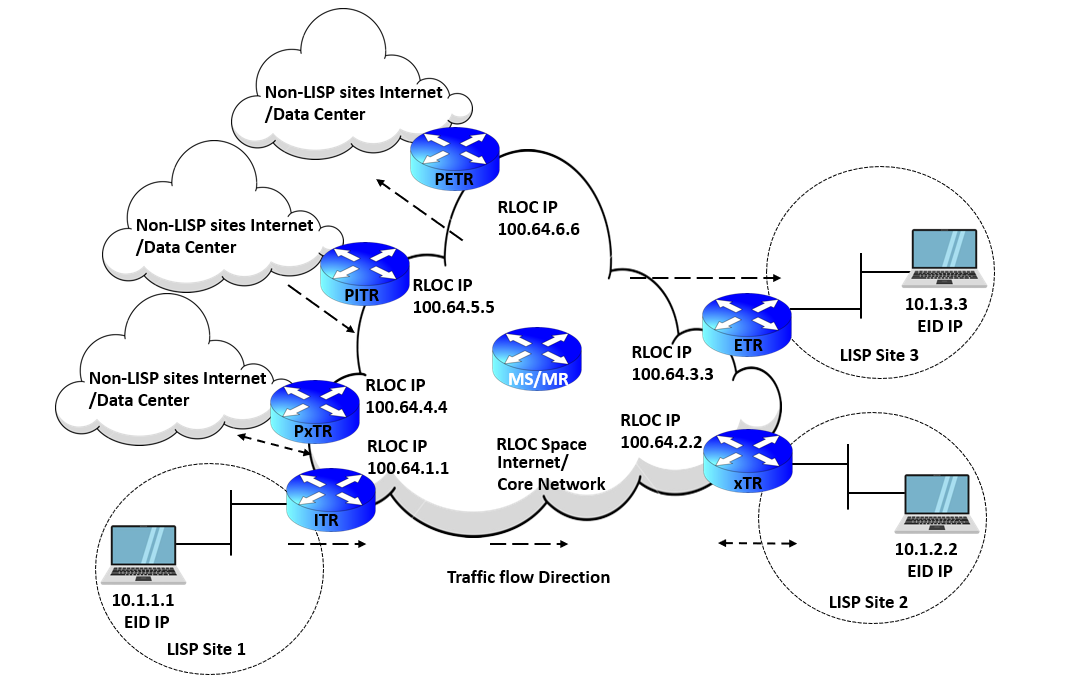Locator ID Separation Protocol (LISP) is a routing architecture and a control and data plane protocol engaging in mapping and encapsulation. Cisco created LISP, but it is an open standard.
With LISP, Cisco uses two separate IP address functions rather than having a single IP address. These are the following:
- Endpoint Identifier (EID) – IP address assigned to the endpoints.
- Routing Locator (RLOC) – IP address assigned to an Egress Tunnel Router’s (ETR) interface facing the Internet or the network core.
There are three important sites in a LISP environment, namely:
- LISP Sites – where the Endpoint Identifiers (EIDs) are stored.
- Non-LISP Sites – where we can find the Routing Locators (RLOCs).
- LISP Mapping Service – responsible for EID-to-RLOC mappings.
The Cisco Locator ID Separation Protocol (LISP) was developed to tackle the Internet’s routing scalability concerns, which include:
- Aggregation: A lot of Internet routes are non-aggregable and not dependent on the provider, which contributes to the large and growing Internet routing table.
- Traffic Engineering: Problems in Internet routing table aggregation and scalability can be aggravated by sites that advertise more specific routes to the Internet.
- Multihoming: Internet multihoming requires the full Internet routing table, which would utilize a powerful router and be costly to deploy in small sites.
- Routing Instability: Internet route instability or route churn uses high CPU and Memory resources. Therefore, a powerful router is also required.
LISP can also be implemented in other environments, such as data centers, campus networks, and service provider cores. It can also serve for applications, such as network virtualization and the Internet of Things (IoT).
LISP Cisco Architecture Components
Below are the Location Identifier Separation Protocol (LISP) architecture components shown in the diagram above:
- Ingress Tunnel Router (ITR) – LISP-encapsulates IP packets from EIDs forwarded outside the LISP site.
- Egress Tunnel Router (ETR) – de-encapsulates LISP-encapsulated IP packets from non-LISP sites destined for EIDs in the LISP site.
- Tunnel Router (xTR) – can execute both ITR and ETR functionalities.
- Proxy Ingress Tunnel Router (PITR) – functions similarly to ITR but for non-LISP sites that send traffic to EIDs.
- Proxy Egress Tunnel Router (PETR) – functions similarly to ETR but for EIDs that send traffic to non-LISP destinations.
- Proxy xTR (PxTR) – can execute both PETR and PITR functionalities.
- LISP Router – A router that functions as ITR, ETR, PITR, and/or PETR.
- Map Server (MS) – learns EID-to-prefix mapping entries from the ETR and stores the entries in an EID-to-RLOC mapping database.
- Map Resolver (MR) – receives LISP-encapsulated map requests from the ITR and checks the Map Server (MS) to locate the proper ETR response to the requests.
- Map Server/Map Resolver (MS/MR) – a device with integrated MS and MR functionalities.
Download our Free CCNA Study Guide PDF for complete notes on all the CCNA 200-301 exam topics in one book.
We recommend the Cisco CCNA Gold Bootcamp as your main CCNA training course. It’s the highest rated Cisco course online with an average rating of 4.8 from over 30,000 public reviews and is the gold standard in CCNA training:

